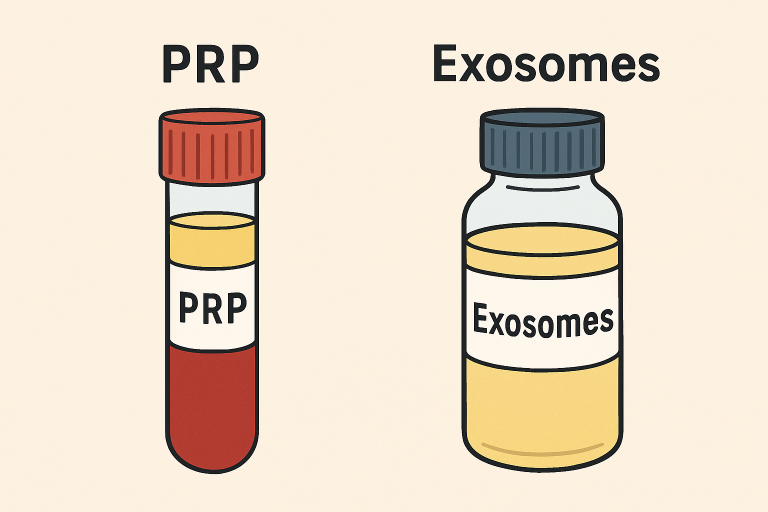As regenerative medicine continues to shape the future of aesthetic treatments, clinics are increasingly evaluating the merits of exosome and PRP therapies. Both are celebrated for their rejuvenating capabilities, but understanding their unique properties, strengths, and limitations is essential for delivering the best patient outcomes. Every practice faces a central question: which therapy, exosomes vs PRP, offers the greatest value and results for clients?
Demand for natural, effective solutions to skin aging and tissue repair has propelled both platelet-rich plasma (PRP) and exosome therapies into the spotlight. While PRP leverages the body’s own healing mechanisms, exosome therapy introduces new regenerative technology that taps into cell signaling. This article offers an in-depth comparison to help aesthetic practitioners choose the most suitable option for their patients and business goals.
Table of Contents
Understanding PRP
Platelet-rich plasma (PRP) therapy is rooted in autologous healing. By extracting a patient’s blood, processing it in a centrifuge to concentrate platelets, and reinjecting it into targeted tissues, clinicians stimulate cell repair and collagen production. PRP is trusted for its safety and has been widely used in cosmetic applications, such as facial rejuvenation and hair restoration, by enhancing the skin’s tone and elasticity through naturally derived growth factors.
Exploring Exosome Therapy
Exosome therapy introduces a new frontier in regenerative aesthetics. Exosomes, nanosized extracellular vesicles, act as communication vehicles between cells. Sourced primarily from mesenchymal stem cells, exosomes transport vital growth factors, proteins, and genetic material, rapidly igniting rejuvenation processes in the treatment area. Unlike PRP, this therapy does not require harvesting blood from the patient; instead, it utilizes laboratory-prepared serum products, delivering consistent performance and simplifying the treatment workflow.
Growing clinical evidence and practitioner experiences highlight the unique ability of exosomes to accelerate recovery and improve skin quality after procedures such as microneedling and laser resurfacing.

Comparing Efficacy
Numerous studies have investigated the effectiveness of PRP and exosome treatments for skin rejuvenation. Peer-reviewed research in the Journal of Cosmetic Dermatology found both PRP and exosomes improved key signs of facial aging, including wrinkles, hyperpigmentation, redness, and texture. Side by side, both approaches stimulated the production of new collagen and glycosaminoglycans—cornerstones of healthy, resilient skin. Ultimately, the efficacy profiles of the two are comparable in the realm of aesthetic medicine, although ongoing research may uncover nuanced differences in how each interacts with skin biology.
Safety and Regulatory Considerations
Safety is paramount when adopting any new treatment. PRP, as an autologous procedure, carries a minimal risk of immunologic reaction or disease transmission and is cleared by the FDA for a select range of medical applications (although not specifically for aesthetic purposes). Conversely, exosome products are not currently FDA-approved for cosmetic use in the United States; regulatory agencies continue to review their safety and purity standards. Strict sourcing and manufacturing protocols must be followed to minimize the risk of contamination or adverse events, and practitioners should remain vigilant about evolving guidance from regulatory authorities.
Practical Implementation
PRP requires phlebotomy skills, sterile blood processing, and specialized centrifuge equipment, which can extend appointment times and cause some patient discomfort due to blood draws. Exosome-based treatments present a streamlined workflow—products arrive pre-prepared and are usually applied topically post-procedure, eliminating barriers for both clinicians and clients. Practices should weigh the operational complexity, staff training, and patient experience associated with each protocol before integrating it into their menu of services.
Cost Analysis
Economic considerations play a crucial role in determining the adoption of therapy. PRP systems incur recurring costs for disposable kits and equipment maintenance, but the blood products themselves are patient-derived and relatively inexpensive. Exosome therapy commands higher per-treatment pricing, reflecting the sophisticated sourcing, laboratory processing, and quality control involved in its production. However, some clinicians report longer-lasting patient outcomes from exosome therapy, which may decrease the need for frequent repeat visits. Completing a thorough cost analysis—factoring in not only product cost but also billing, chair time, and follow-up—is key to maximizing both value and profitability for your practice.
Patient Preferences and Outcomes
Patient comfort, expectations, and desired outcomes should always be at the heart of treatment selection. Some individuals are reassured by PRP’s status as a natural, autologous treatment and are willing to accept the blood draw for peace of mind. Others prefer the convenience and less invasive nature of exosome therapies. Regularly assessing patient-reported outcomes, collecting testimonials, and monitoring the frequency of adverse events enables practices to tailor their offerings to meet demand and establish a strong reputation within the aesthetic community.
Conclusion
The decision between exosomes and PRP in an aesthetic practice is multifaceted, shaped by clinical outcomes, regulatory status, economic impact, and patient preferences. While both treatments are proven to stimulate skin regeneration and healing, implementation logistics, safety profiles, and long-term results may influence practitioners’ decisions, leading them to favor one therapy or use both, depending on the client’s selection. Staying informed and agile as research and regulations evolve will enable clinics to continue delivering exceptional standards of care in regenerative aesthetics.
